Create Message
Learn how to create an RCS Message campaign using the CleverTap dashboard
Overview
RCS (Rich Communication Services) campaigns in CleverTap allow you to engage users with rich, interactive messaging experiences. This guide walks you through the step-by-step process of creating, configuring, and launching an RCS campaign—from selecting the provider and defining your audience to crafting message content, scheduling delivery, and publishing the campaign.
- Create a new campaign from the CleverTap dashboard and select RCS as the message provider.
- Configure the campaign setup:
- Define qualification criteria (Past behavior, Live behavior, or Custom list).
- Set an optional goal for conversion tracking.
- Choose your RCS service provider.
- Define your target audience:
- Use behavioral segmentation, user properties, demographics, and geographic filters.
- Use advanced options like:
- Select the message type:
- Define Message content using the RCS Message Editor with approved or freeform templates.
- Set up the campaign schedule:
- Preview and publish your campaign.
Create a New Campaign
Create a campaign to deliver your RCS message. Follow the steps below to create a new RCS campaign:
-
From the CleverTap dashboard, select Campaigns.
-
Click + Campaign.
-
From the Messaging Channels list, select SMS.
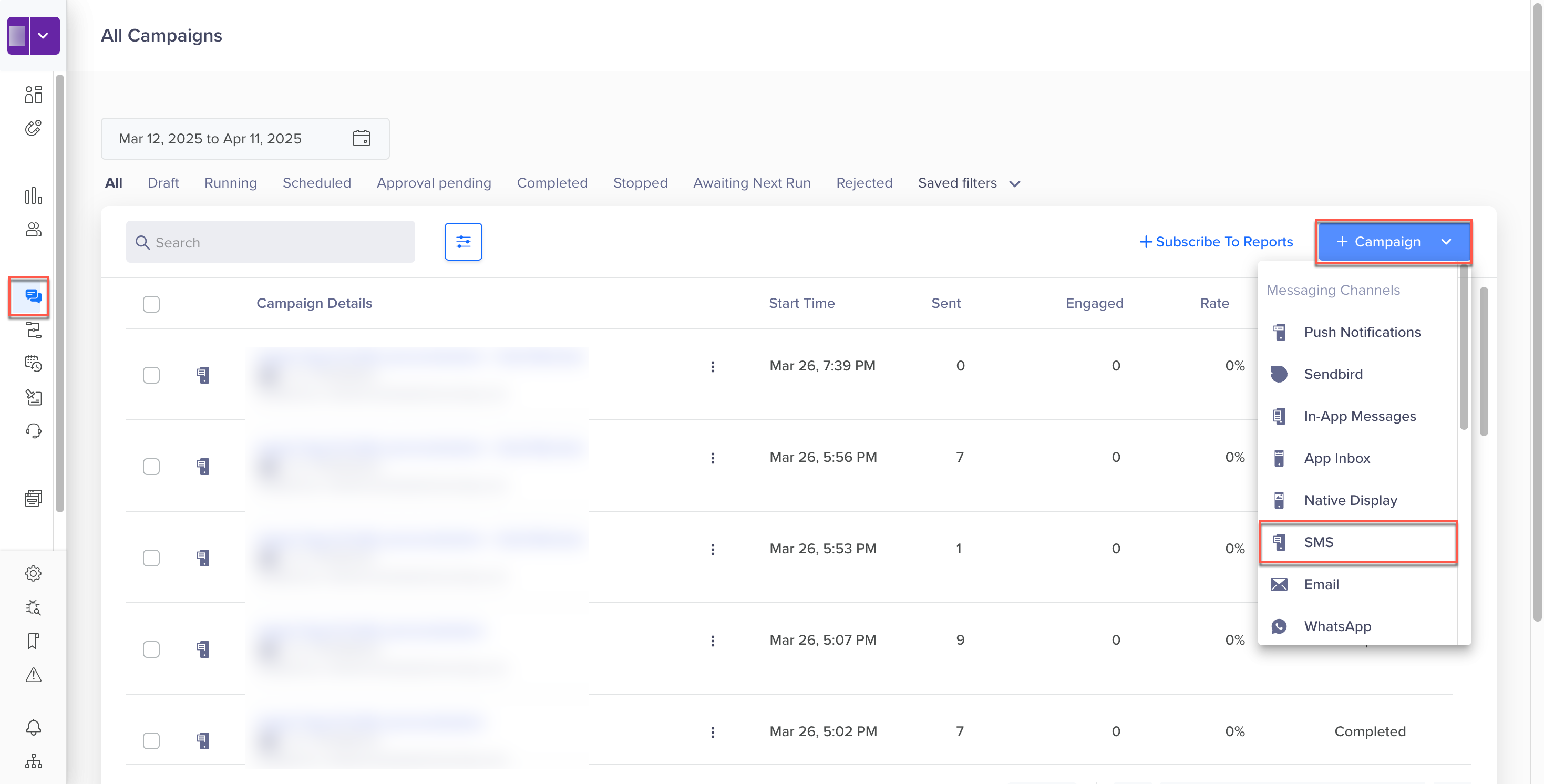
Create RCS Message Campaign
The campaign page displays. In the SMS Campaign Builder, go to the Provider dropdown, select RCS Message Provider.
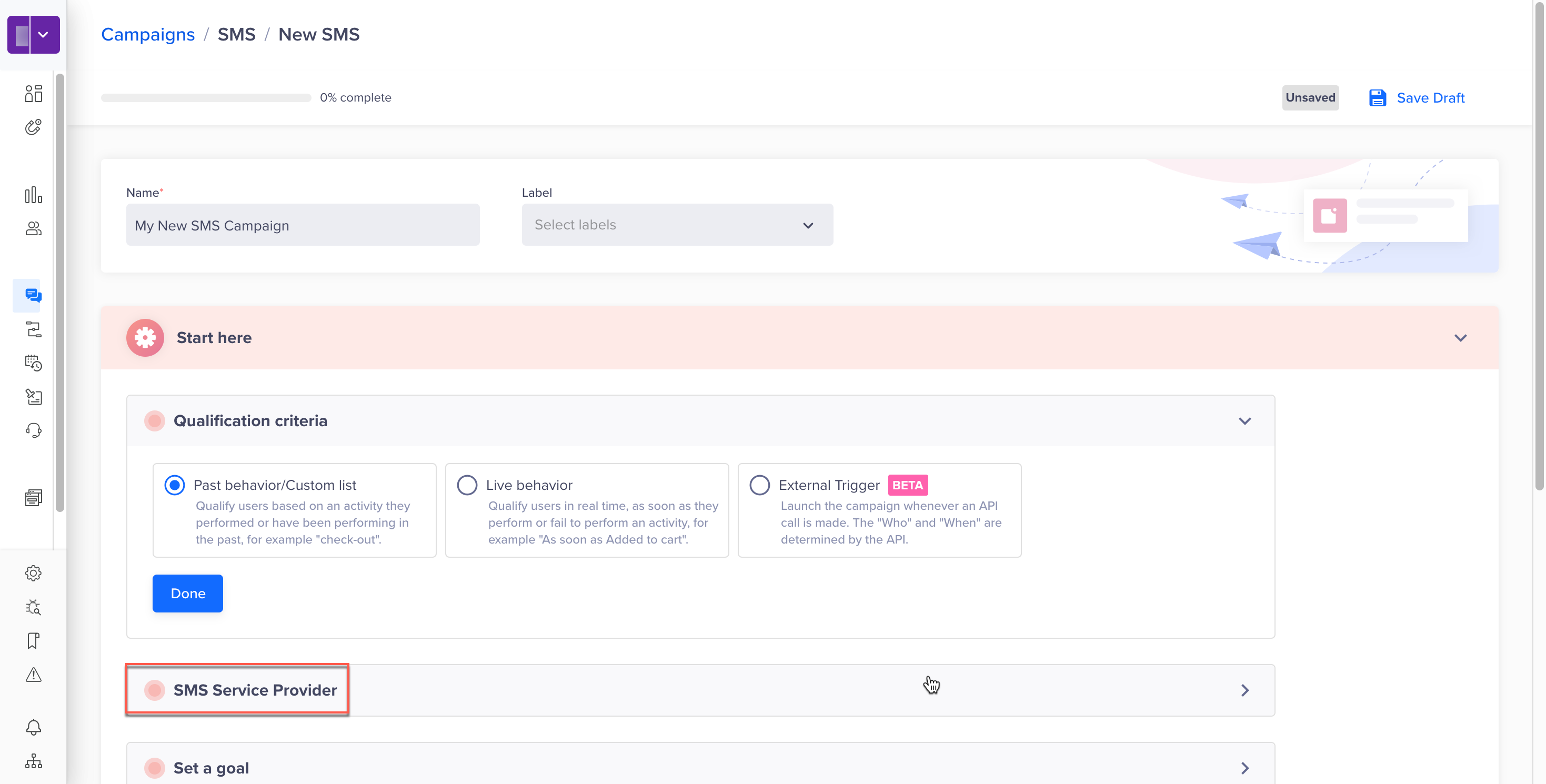
RCS Campaign Page
Define all the sections and Publish the campaign.
Start Campaign Setup
The Start here section displays the setup information.
This section has the following parts:
- Start here: Check that the required platforms are integrated and ready for campaigns.
- Qualification criteria: Deliver the notification based on Past behavior, Custom list, or Live behavior For more information about segmenting users, refer to Segments.
- RCS Service Provider: Select the available RCS service provider from the list.
- Set a goal: You can track your campaign conversion by setting up a goal. Setting a goal allows you to measure your campaign effectively against what you want to achieve with the campaign. This selection is optional.
Define the conversion period by selecting the Conversion Time. You can define your conversion goal further by filtering an event by event properties. For more information on event properties, see Events.
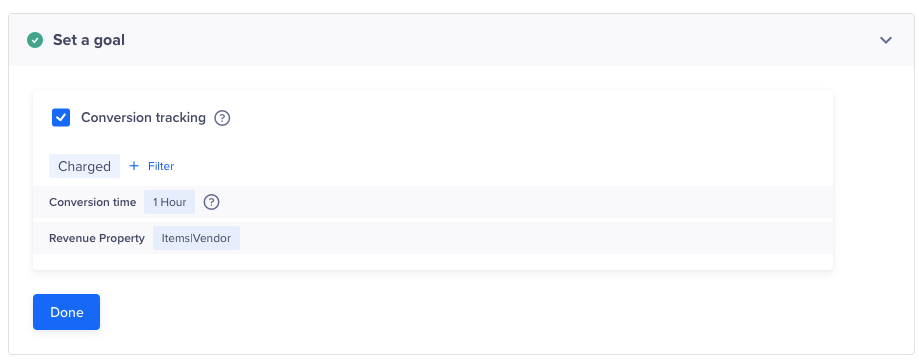
Goal Conversion Tracking
Define the Audience
You must indicate the target audience for your RCS campaign. You can target your RCS campaign to a new user segment by clicking on the Target Segment section. Here, you can create a new segment or use a previously saved user segment from the segment list.

Segment Your Target Audience
You can create the target based on past user behavior and user properties or live (ongoing) user behavior. The latter is helpful to send out real-time, triggered campaigns.
Delay > 24 HoursWe recommend creating a Past Behavior campaign for all campaigns where the delay is greater than 24 hours for a live inaction campaign.
For instance, you can create a live Inaction within time campaign that targets users as soon as they add a product to their cart but do not finish transacting within 10 minutes; the golden window within which most users transact on online platforms.
Deliver Action Based RCS Notifications
You can trigger a RCS message to users when they perform a specific action. This makes notifications more contextual and increases conversion. For example, sending a cab booking link to customers who have just booked a hotel or flight.
Deliver RCS Notifications based on Past Behavior (PBS)
You can also target users basis their past behavior. For example, you might want to target customers who have purchased a specific product in the past.
Filter by User Properties
Using the With user properties filter in the Who section, you can segment your campaign to reach users who meet specific criteria.
For example, you can send a RCS notification to all the customers from Mumbai who are currently subscribed to Platinum membership.

Filter by User Properties
The following table explains the various property types:
Property Type | Description | Example |
|---|---|---|
User Properties | Custom user profile properties that you define and send to CleverTap. | Customer Type = Platinum |
Demographics | Demographics filters include Age and Gender. | Age = 25 to 40 years |
Geography | User's coarse location. Filters include Country, Region, and City. CleverTap's SDK can automatically detect this from the user's IP address. | Country = United States |
Geography Radius | User's exact location. You can select a city, and then define the target radius. You can also select multiple cities. You can send this information using CleverTap's SDK. For more information, refer to the iOS and Android developer guides. | Locations = San Francisco, USA; Paris, France |
Reachability | Reachability filters include Has email address, Has phone number, Unsubscribed email, and Unsubscribed SMS. | Unsubscribed email = No |
App Fields | App fields filters include App Version, Device Make, Device Model, OS Version, and CleverTap SDK Version. This information is sent by CleverTap's SDK for each device that has your app which means a single user can have multiple devices associated with their user profile. | OS Version = 10 |
To know more about what segments can be used, see Segments.
Constant event property
You can also hold a property constant across the selected events. For more information, see Constant Event Property.
Control Group
You can define the control group to compare and measure the results of your campaign. For more information, refer to Control Groups.
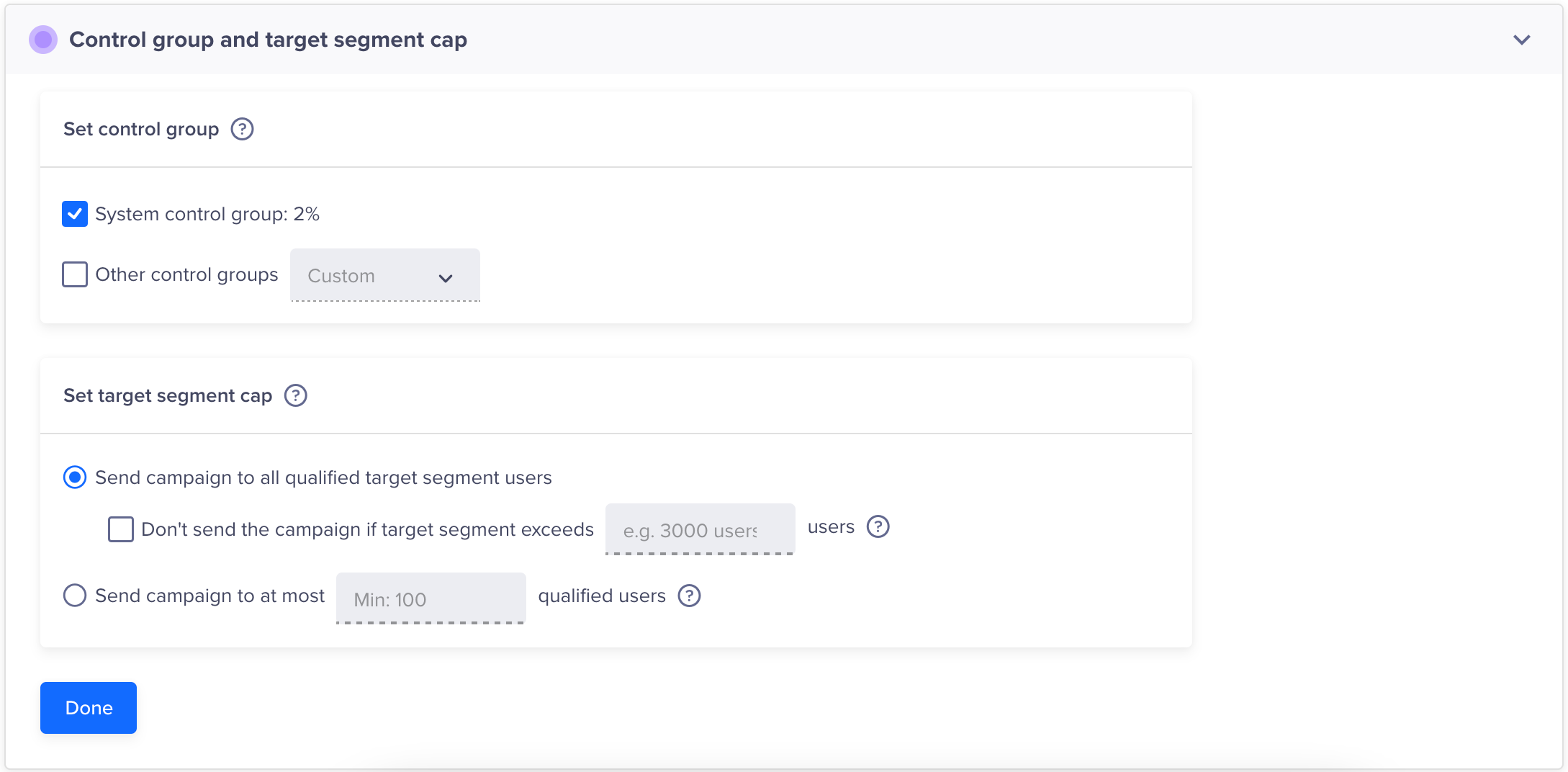
Control Group Editor
Targeting Cap
In certain cases, you may need to send a message to only a subset of the qualifying audience (Target Reach) for a campaign or avoid sending it if the number of qualified users exceeds the specified number.
A relevant use case is a limited offer where you want to send a fixed number of coupon codes you want to distribute. If the total reach for your campaign exceeds the number of coupon codes you can distribute, you can limit the number of users who will receive the message to exactly the number of coupons you want to distribute.
Campaign LimitEnsure that you set up a limit of 100 or more, regardless of the qualified user segment size. If the limit specified is less than 100, an error occurs.
RCS Message Types
You can create the following types of messages in your RCS campaign:
- Single Message
- A/B Test
- Split Delivery
- By User Property
Legacy UIA/B Test and Split Delivery message types are only available for new campaign UI.
Single Message
In this campaign, a standard message is sent to all users who qualify as your target audience. This message type is best for broadcast messages and for applications that do not vary campaign communication based on differences between properties such as language, geography, or any other user properties.
A/B Testing
A/B testing helps you understand what type of message copy works best to get clicks from users.
You can test up to three message variants on a test group.
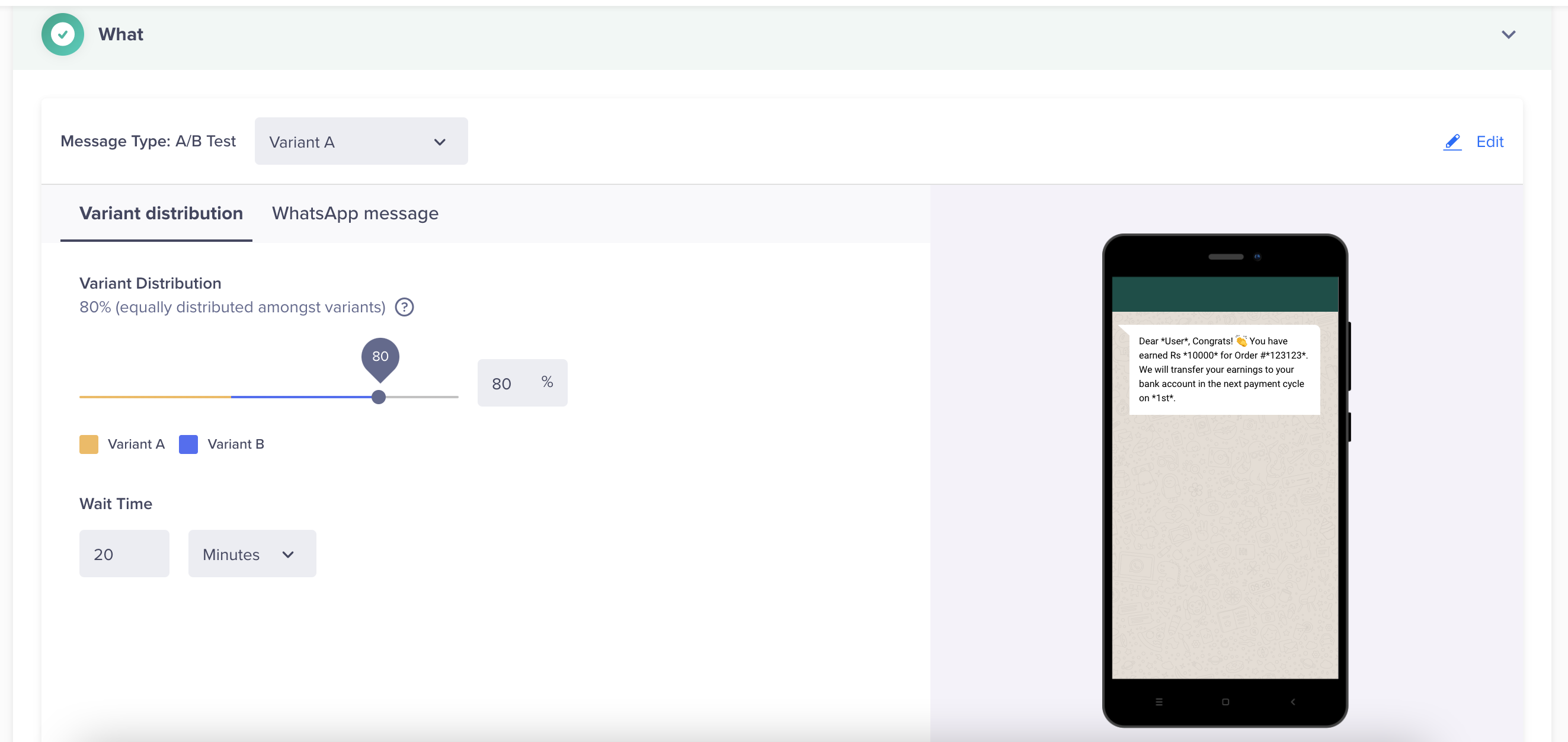
RCS A/B Tests
Winning VariantThe variant that gets the most views is declared the winning variant and is automatically sent to the rest of your target audience.
When you create multiple variants (max: 3 variants) for a campaign, you can also auto-copy the content present in the current variant. Further, let us understand A/B Test delivery for Live user segments.
A/B Test Delivery To Live User Segments
With campaigns sent to live user segments (triggered campaigns), messages are delivered immediately when a user’s activity matches the criteria you have selected. For example, you can send a message when the user has completed a booking or purchase. Since it is not possible to determine the reach of triggered campaigns upfront, you need to decide how many total messages to send for A/B testing before a winner is declared.
Triggered Campaign ExampleIf you select 500 users as your test audience, we will alternate delivery of Variant A and Variant B as users qualify for the campaign. After a total of messages are sent (Variant A – 250 and Variant B – 250), we then decide the winner based on the number of views and continue only with this winning message for the duration of the campaign.
Deciding on a test audience for A/B testing triggered campaigns requires some estimation. We recommend you check the total messages that were sent for similar triggered campaigns in the past to get a sense of how many users may qualify. If you select a test audience that is too small such as 25 users, you will get a statistically insignificant sample. If your test group size exceeds the total number of users who ultimately qualify for that campaign, then no winner will be declared and each message variant will be alternatively delivered for the duration of the campaign.
Split Delivery
With split delivery, you can decide what percentage of your audience receives each message variant for the duration of the campaign.
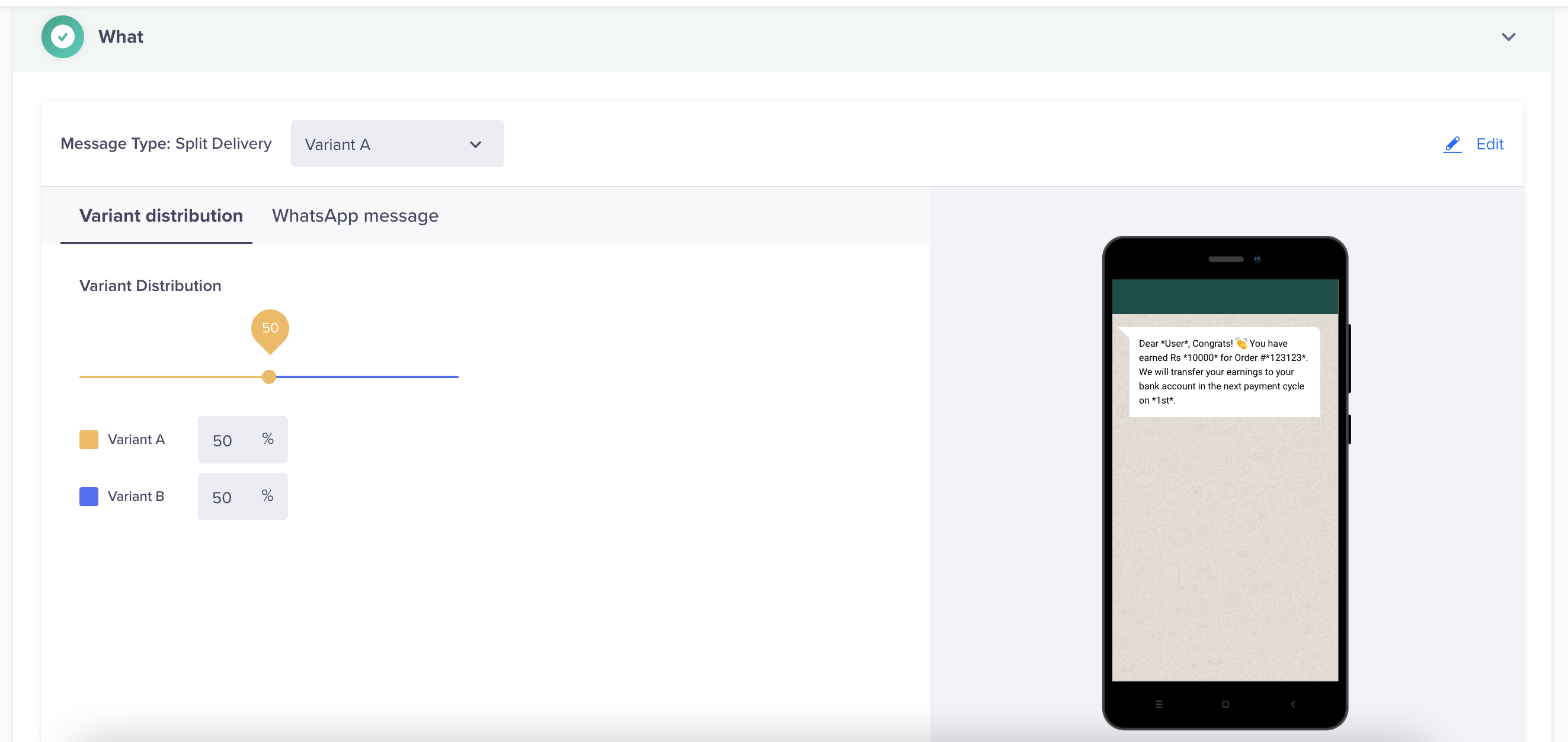
RCS Split Delivery
By User Property
If you would like to send different message variants to your target audience based on the user properties they possess, this campaign type is your best bet. A good example would be when you want to send a localized update to people based on their preferred language.
Similar to creating A/B test variants, you can use the +Variant button to add multiple variants based on a user property value. In the example below, we have used the Language user property so users with different language preferences will receive corresponding copies of the campaign in their preferred language (English, Hindi, etc.)
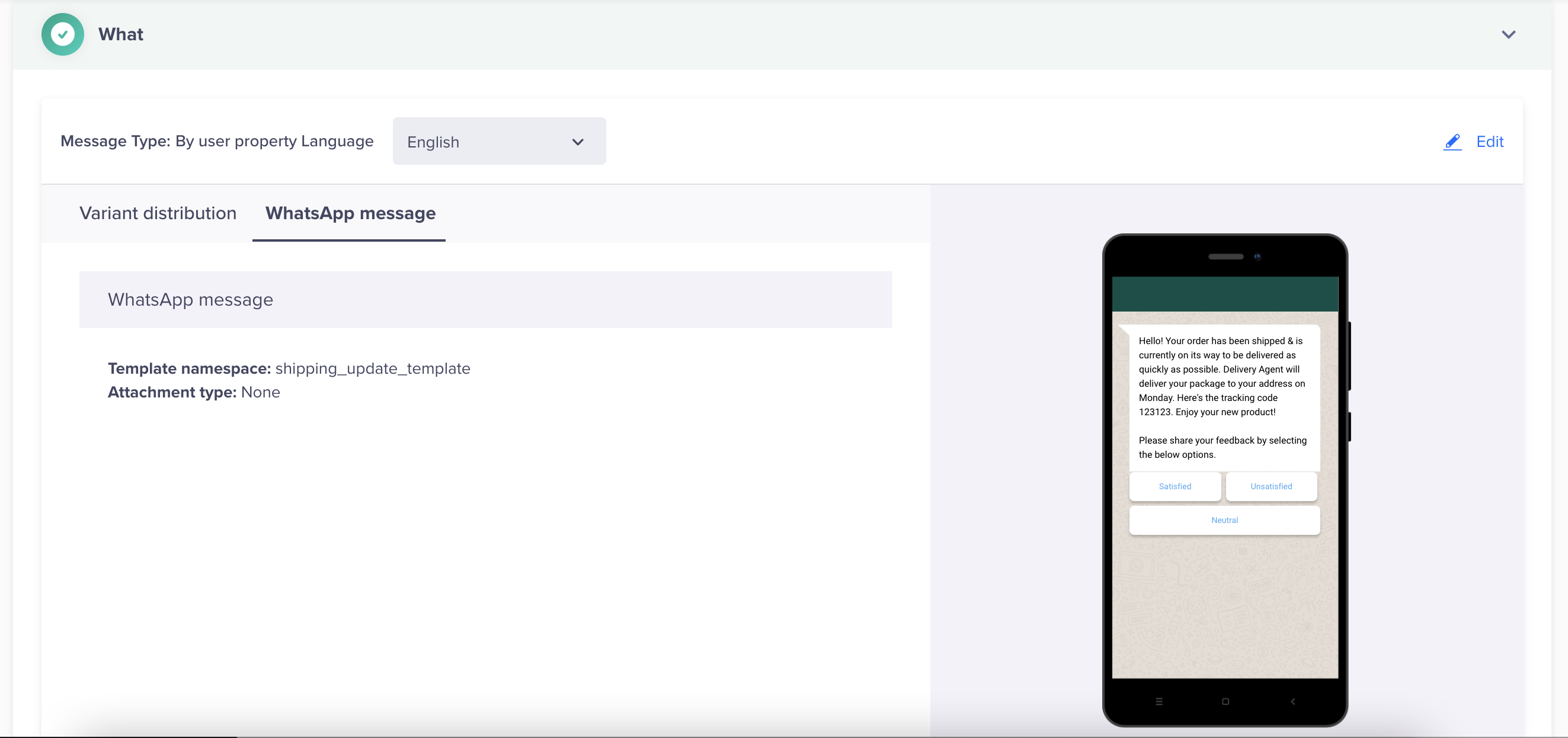
Targetting Based on User Property
Define the Message Content
Now, you need to set up the What section where you have to define the content for the RCS campaign Click Go To Editor to create your message.

Define Message Type
RCS Message Editor
Select from the approved templates for Indian users and free form templates with placeholders for users outside of India.
RCS Editor
Select from the approved templates.
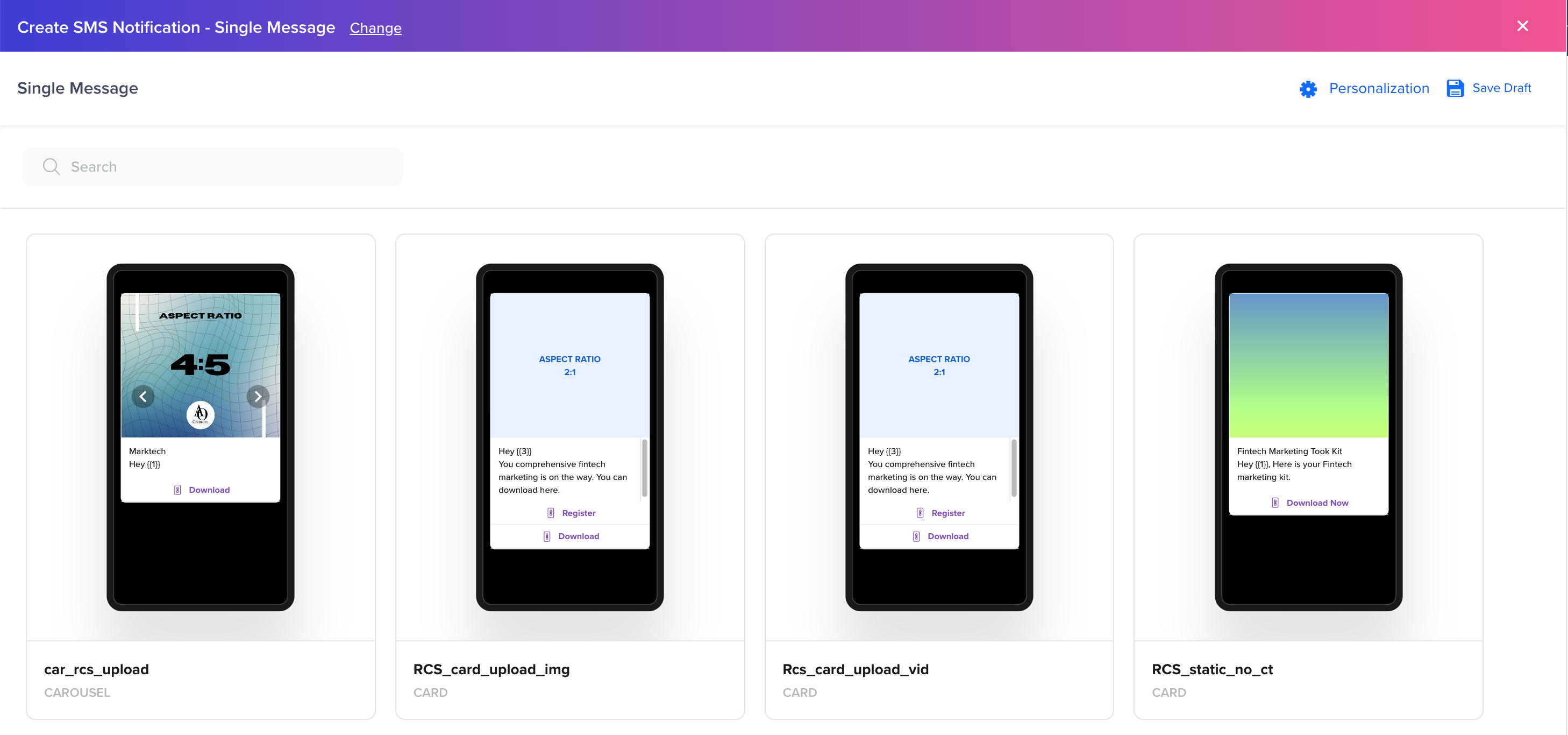
Select a Template
Fill in the details and click Done. For information about using RCS Message editor, refer to RCS editor.
Define the Campaign Schedule
The RCS message campaign needs to be scheduled to run actively for a specific timeline. To define the schedule for your RCS campaign, you need to specify the Start date and time and End date and time under the When section. You also have the option to start a campaign immediately by selecting Now. Besides, you can also define a delay (by seconds, minutes, hours, or days) once a user qualifies for the target segment. Once you define the schedule and click on Done, the campaign will be triggered and terminated as per the defined timings.
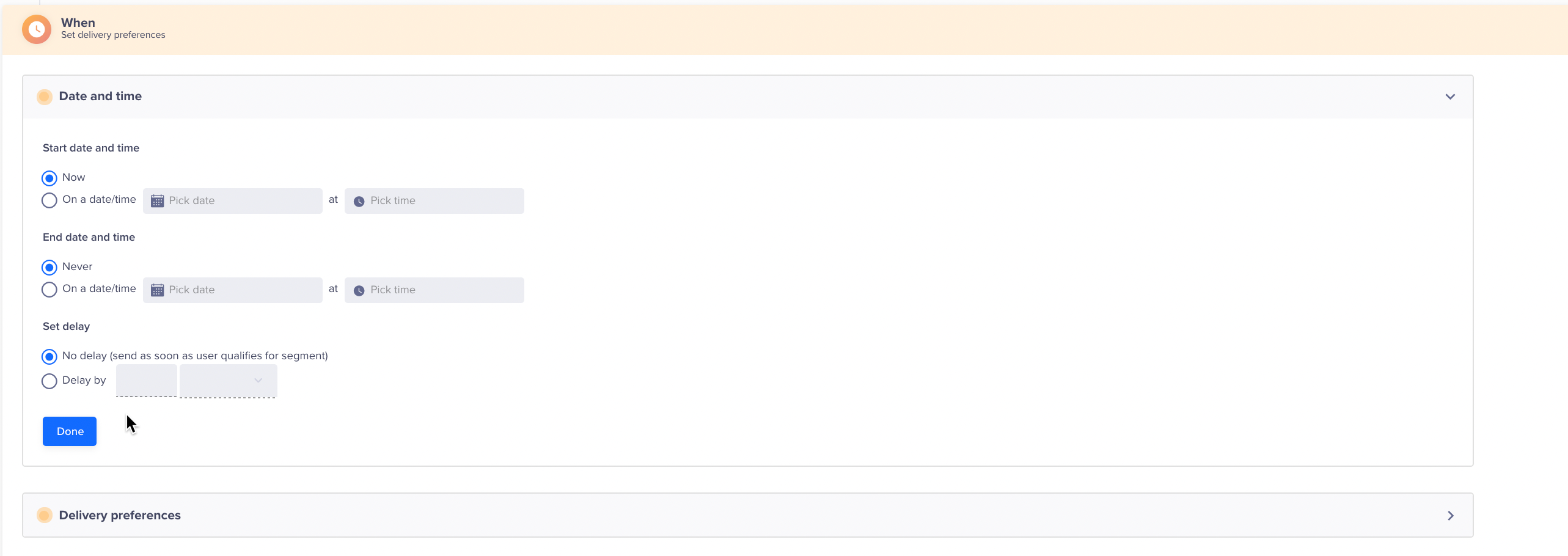
Define The Campaign Schedule
Delivery preferences
In certain scenarios, you might not want a campaign to run actively on a particular day and time. In such cases, you can set the frequency for that particular campaign.
You can select the Do Not Disturb (DND) hours during which messages from this RCS campaign are prevented from going out, either by discarding them or delaying delivery after DND hours complete, such as 9 PM to 9 AM.
If you want your campaign to adapt delivery times according to the user’s timezone, check the Timezone checkbox. For more information, refer to Delivery in User’s Timezone.
Additionally, you can check the Cut-Off checkbox to avoid sending messages to users after a set cut-off time. This is important for time-sensitive campaigns, for example, live events.
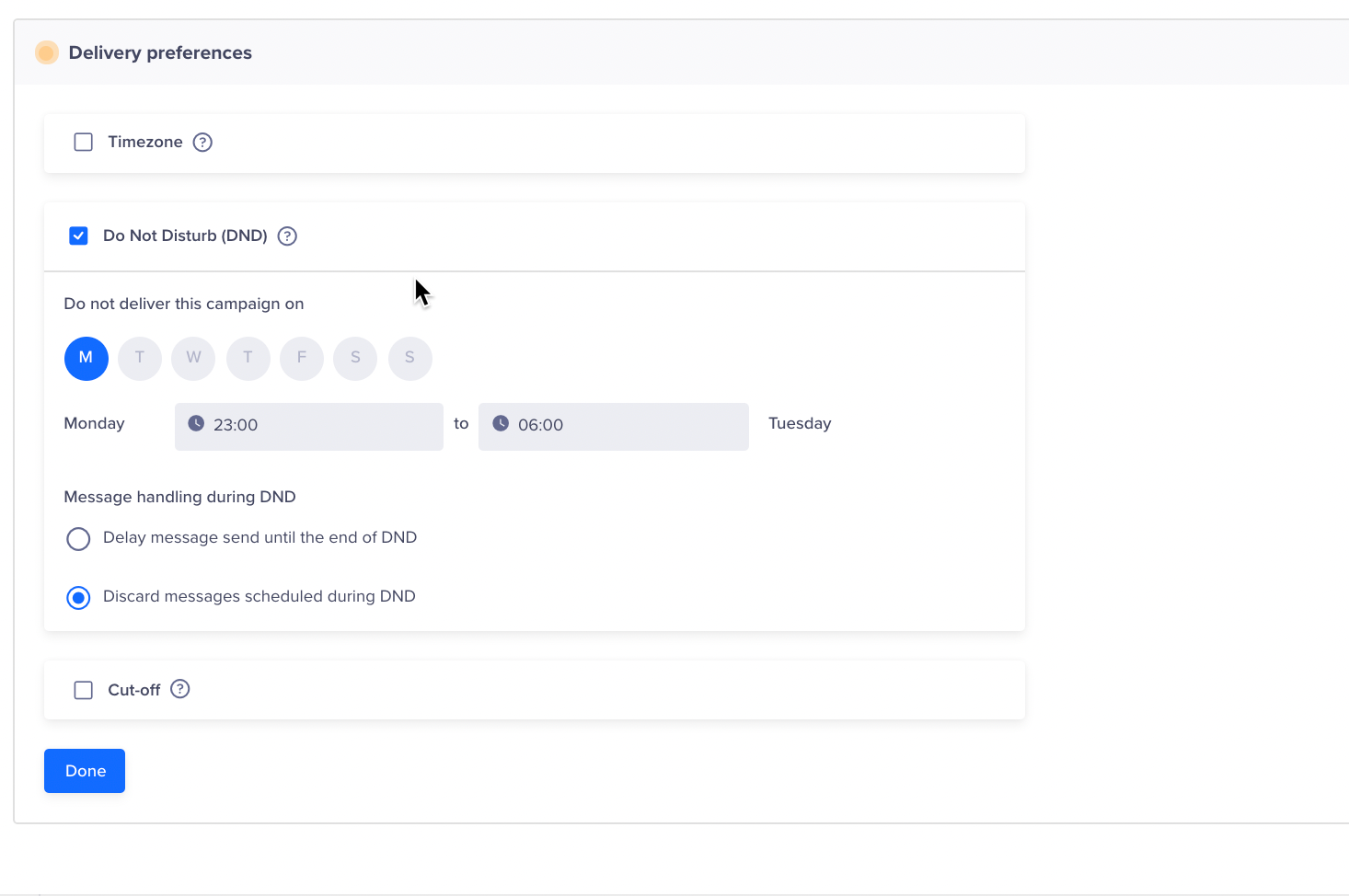
RCS Delivery Preferences
Publish Campaign
After previewing the appearance of your overall campaign, finalize your campaign by clicking Publish Campaign.

Publish Campaign
Updated 3 days ago
